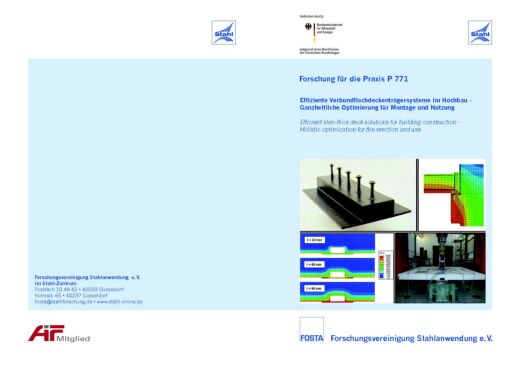Description
P 771 – Efficient slim-floor deck solutions for building construction – Holistic optimization for the erection and use
So far, composite girders were considered as isolated structural elements, integration into a system, especially the design of composite joints, the connection of the composite girder to other structural elements like columns for example was left to practice. The aim of this project is the integrated approach of an economic design of slim floor girder on one hand and an appropriate joint design on the other. Main focus of the research project was on questions of serviceability, especially the necessary fulfillment of deformation criteria, furthermore the design of joints suitable for mounting. Similarly, the problem of fire protection plays a decisive role in composite joint solutions. In this context, solutions for a design of girders in terms of fire protection of the girders as well as for the joints have been developed.
For the deformation behavior of composite slim floor girder systems, a non-linear calculation approach on the basis of a large scale analytic examination could be deducted and with this respect, the so called deformation based effective width has been introduced. This calculation approach was further developed to a linear approach in a second step which enables to calculate very easily the non- inear structural behavior bymeans of linear deformation approaches. A comparison of existing codes shows that existing approaches are conservative and the bending is strongly overestimated. So by this new approach realistic deformation may be calculated and an efficient design of the slim floor girders is possible. For the design of joints, construction solutions which allow a very economic application of these steel connections were demonstrated on typical sections. Besides hinged connections, also examples for a rigid (continuous) girder connection are shown which may be activated with respect to the system reserve in case of fire. The demonstrated system solutions show that the consequently efficient system solution can be transferred from the girder to the connection. The aim of the third work package was to examine the fire resistance of typical slim floor systems and, if necessary, to improve by constructive measurements. The analytic solutions show that all girders possess a fire resistance period of R30 without additional efforts. A significant increase of fire resistance can be achieved by the design of continuous systems. Here carrying reserves can be activated which provide a decisive advantage for the fire design.
Through the results of the project slim floor slab solutions are feasible that allow aside of economic efficiency additional advantages such as reduction of erection time by appropriate prefabrication and joint detailing, user comfort by reduced deformations and safety also in case of fire.
The research project (IGF-Nr. 15675 N) has been carried out at Universität Stuttgart from Institut für Kon-struktion und Entwurf and from Gottfried Wilhelm Leibniz Universität Hannover at Institut für Stahlbau. FOSTA has accompanied the research project work and has organized the project funding from the Federal Ministry of Economics and Technology through the AiF as part of the programme for promoting industrial cooperation research (IGF) in accordance with a resolution of the German parliament.
Only available in german language.
Authors:
U. Kuhlmann, G. Hauf, P. Schaumann, T. Kirsch, N. Sauerborn
Published in:
2014




